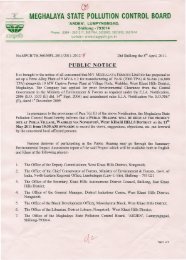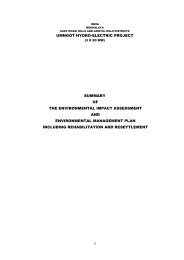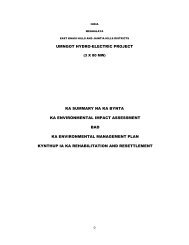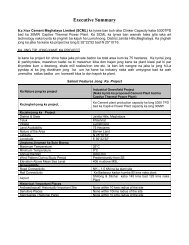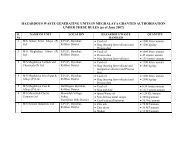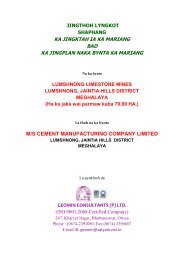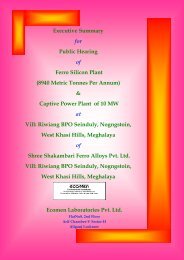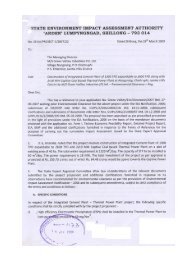chapter - 1 introduction - Meghalaya State Pollution Control Board
chapter - 1 introduction - Meghalaya State Pollution Control Board
chapter - 1 introduction - Meghalaya State Pollution Control Board
You also want an ePaper? Increase the reach of your titles
YUMPU automatically turns print PDFs into web optimized ePapers that Google loves.
Hills Cement Co. Limited.<br />
High efficiency classifiers can be used in both the raw materials mill<br />
and in the finish-grinding mill.<br />
4. Standard classifiers may have a low separation efficiency, which leads<br />
to the recycling of fine particles, and results in to extra power use in<br />
the grinding mill. In high-efficiency classifiers, the material stays longer<br />
in the separator, leading to sharper separation, thus reducing over<br />
grinding. Electricity savings through implementing high-efficiency<br />
classifiers are estimated at 8% of the specific electricity use.<br />
6.2. FUEL PREPARATIONS<br />
1. Coal is the most widely used fuel in the cement industry. Fuels<br />
preparation is most often performed onsite. Fuels preparation may<br />
include crushing, grinding and drying of coal. Coal is shipped “wet” to<br />
prevent dust formation and fire during transport. Passing hot gasses<br />
through the mill combines the grinding and drying. Waste heat of the<br />
kiln system (e.g. the clinker cooler) is used to dry the coal if needed.<br />
6.3. CLINKER PRODUCTION – ALL KILNS<br />
(i) Process <strong>Control</strong> & Management Systems – Kilns- Heat from the kiln<br />
may be lost through non-optimal process conditions or process<br />
management. Automated computer control systems may help to<br />
optimize the combustion process and conditions. Improved process<br />
control will also help to improve the product quality and grind ability,<br />
e.g. reactivity and hardness of the produced clinker, which may lead to<br />
more efficient clinker grinding.<br />
(ii) Expert control systems do not use a modeled process to control<br />
process conditions, but try to simulate the best human operator, using<br />
information from various stages in the process.<br />
(iii) An alternative to expert systems is model-predictive control using<br />
dynamic models of the processes in the kiln. A model predictive<br />
control system can reduce energy needs by 4%, while increasing<br />
productivity and clinker quality.<br />
(iv) Additional process control systems include the use of on-line<br />
analyzers that permit operators to instantaneously determine the<br />
chemical composition of raw materials being processed in the plant,<br />
thereby allowing for immediate changes in the blend of raw materials.<br />
(v) A uniform feed allows for steadier kiln operation, thereby saving<br />
ultimately on fuel requirements.<br />
<strong>Pollution</strong> <strong>Control</strong> Consultants (India) Pvt. Ltd. 117



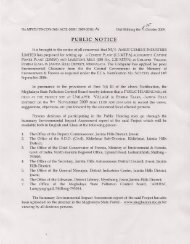
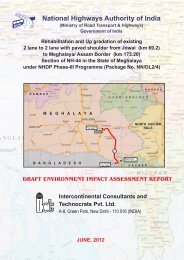

![[FORM I] - Meghalaya State Pollution Control Board](https://img.yumpu.com/49771786/1/190x245/form-i-meghalaya-state-pollution-control-board.jpg?quality=85)

